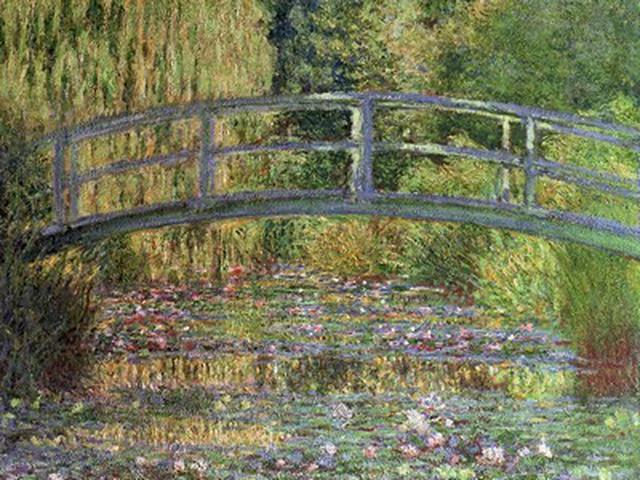The bridge over a water lily pond

The Bridge Over a Water Lily Pond is an 1899 work by French Impressionist Claude Monet. Monet painted the work using oil on canvas. The painting measures 36.5 x 29 inches. The painting is in the Metropolitan Museum of Art in New York and was bequeathed to the Metropolitan Museum as part of the Havemeyer in 1929.
Monet, as a passionate horticulturist, bought land with a pond near his property in Giverny, with the intention of building something "for the pleasure of the eye and also for painting." The result was his water lily garden. In 1899, he began a series of eighteen views of the wooden walkway over the pond, completing twelve paintings, including the current one, that summer. The vertical format of the image, unusual in this series, gives prominence to the water lilies and their reflections in the pond.
The pond is surrounded by lush green vegetation. A clear blue sky can be partially seen through the trees, and is also reflected in the pond water. Tall grasses, reeds, and other vegetation are also reflected. Admitting since 1901 his obsession with painting the water garden, Monet visited it at least three times a day to study the changing light, recording the details in his notebooks. He continued painting his lily pond until he died, his compositions becoming larger and more abstract. In fact, in his latest series, he completely ignores the banks and the bridge, and focuses exclusively on the surface of the water, creating a series of abstract paintings filled with light and watery colors.
Claude Monet was born on November 14, 1840 in Paris, France. He enrolled in the Swiss academy. After an art exhibition in 1874, a critic insultingly called Monet's painting style "Impression" as he was more concerned with form and light than realism, and the term stuck. Monet struggled with depression, poverty, and illness throughout his life. He died in 1926.
Monet sometimes became frustrated with his work. According to some reports, he destroyed a number of paintings; Estimates vary up to 500 works. Monet would simply burn, cut or kick the offending piece. In addition to these outbursts, he was known to suffer from bouts of depression and self-doubt.
© Tourblink